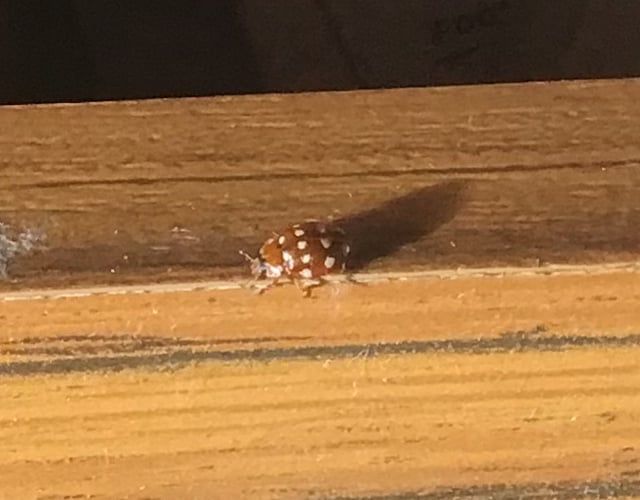
Our ladybirds theme this week was prompted by a photo emailed by reader Steve Davies, who wished to show an unusual ladybird he spotted in his house.
What Steve saw is a cream-spot ladybird which has 14 cream spots on a brown body. There's another ladybird called the orange ladybird but that's a brighter orange colour and its spot pattern is distinctively different from the one Steve saw.
Ladybirds belong to a family of beetles known as Coccinellidae, which includes over 3,500 species worldwide. Over 40 species are resident in the UK, of which 26 are “conspicuous ladybirds” – that is, they are brightly coloured, with many sporting the familiar polka dot pattern.
Gardeners have always welcomed ladybirds on their patch because they feast on aphids – greenfly and blackfly – so are important in keeping aphids in check.
If you’re of advanced years, like me, you may have noticed that the ladybirds nowadays vary much more in their colours and spots, compared with a few decades ago.
The ladybirds I saw most often when I was growing up were the 7-spot ladybird, which always has red wing cases with seven black spots, and the 2-spot ladybird which usually has red wing cases with one black spot on each side, but is sometimes black with red spots.
Also common were the 14-spot ladybird, yellow with rectangular black spots (which often join up), and the eyed ladybird whose black spots are surrounded by a pale ring.
The ladybirds mentioned so far were those most likely to be seen in the UK until quite recently. The game changer has been the non-native harlequin ladybird which originated in Asia. Apparently it was introduced to North America and mainland Europe in the 1980s to control aphids that were feeding on crops.
It appeared in Britain in 2004 (possibly after being blown over by winds) and spread quickly across the UK. It is already the ladybird species most likely to be seen in parks and gardens.
Harlequins are voracious predators and can out-compete our native species for aphids. They will also eat the eggs and larvae of moths, butterflies and other ladybirds. Harlequins can have multiple broods throughout the spring, summer and autumn, which also gives them a competitive edge over our native ladybirds.
They are extremely variable, with up to 21 black spots on a red or orange background, or even black with red spots.
The simplest way to tell a harlequin from a native ladybird is that it has orange legs and its underside is orange, whereas native ladybirds have black legs and are black underneath.
The head of a harlequin usually has a conspicuous white triangle (which native ladybirds lack) and the part just behind the head (called the pronotum) often has an “M” or “W” marking depending on the way you view it.
A search online reveals several web pages describing the most common UK ladybirds, with photos. For UK beetles generally (of which over 4,000 species can be found in the British Isles) there is a fascinating website at www.coleoptera.org.uk.
This site invites everyone to enter details of the beetles they see, including ladybirds, as part of surveys of beetles generally and ladybirds specifically. The site also includes a ladybird identification sheet to help you distinguish the harlequin from other native British ladybirds: you can download it here: https://tinyurl.com/harle6





Comments
This article has no comments yet. Be the first to leave a comment.